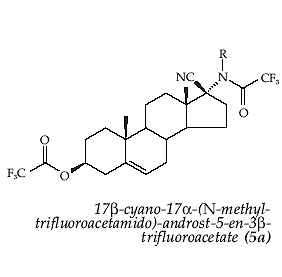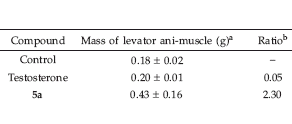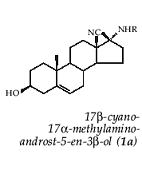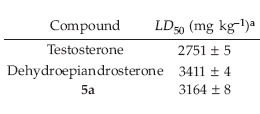|
Definition: "An ergogenic aid is any substance or phenomenon that enhances performance "
|
|
||||||||
26.04.2009 |
|
|
Anabolic effect of giant Egyptian androgens exceeds that of testosterone
It's a factual article, with information on synthesis routes and the biological activity of the new compounds. The most successful, in terms of the anabolic-androgen ratio, is compound 5a. Full name: 17-cyano-17alpha-(N-methyl-trifluoroacetamido)-androst-5-en-3beta-trifluoroacetate.
It's shown in the diagram below. Beware, though: it bites.
The researchers gave experimental animals a daily 0.1 mg per kg bodyweight of the steroid for a week. At the end they measured how much the sphincter muscle and the prostate had grown in the rats. These are markers respectively for the [desired] anabolic and [undesired] androgenic effects of the new steroids.
The table below shows the performance of testosterone and component 5a. The ratio between the anabolic and the androgenic working of testosterone is 0.05. The ratio of compound 5a is enough to make your flesh creep.
Another steroid with a comparable effect mentioned in the publication is steroid 1a, with an anabolic-androgenic ratio of 2.20. Steroid 1a is shown below.
The chemists we consulted doubt whether the compounds mentioned in this article really do have the effects measured in the animal tests. They criticise the Egyptians, saying they have assumed that the steroids administered are the active components.
Which metabolites these might be is not clear from the article. "The acetates and trifluoracetates will be the first to hydrolyze at any rate," predicts De Groot.
When the new steroids described in the article metabolise, poisonous compounds could in theory be created. But when the researchers pumped megadoses of the new steroids directly into the gut of rats, however, there were few signs of acute poisoning.
The LD50 of the new steroids is comparable to that of testosterone and DHEA.
Source:
|
|




